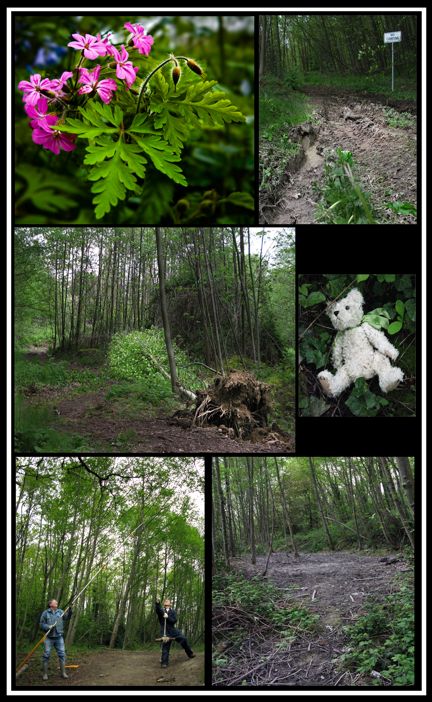
Exactly one week after we brought you first word of the Camp Long homeless encampment (cleared on Friday) that WSB contributing photojournalist Matt Durham had documented, he has a two-part postscript. First, his newest photos above, clockwise from top, and his captions below:
1. Spring rears its head along the trails leading to the removed encampments at Camp Long.
2. The encampment and its removal scarred nearly 50 yards of trail with deep ruts and the litter. Parks Department workers are limited in their resources to properly restore the park, given other demands.
3. A teddy bear, along with other human waste, continues to litter the area surrounding the dismantled encampment.
4. Large areas of forest floor are trampled and impregnated with leftover refuse from the encampments.
5. Parks Department workers remove a rope swing, near the homeless encampment, to reduce the chance of serious injury to park visitors.
6. A Seattle Parks Department wheel loader knocked a tree down to maneuver close enough to remove a large quantity of human refuse.
Second, Matt has written commentary about an idea he suggests could prevent such encampments and enhance park usage. Read on:
Commentary by Matt Durham
www.MattDurhamPhotography.com
This story is not about punishing the homeless, nor is it condoning destruction; this story is about vision. To have a vision you must understand where you reside.
Most of the comments resulting from my photos were well-intentioned; they just lacked foresight.
How do we protect our urban outdoors? In part, good parks’ design incorporating good marketing.
Encampments and vandalism stem from underusage. The parks don’t have children running over logs and through the creeks, as once was the case. This lack of traffic results in less community policing.
Thoughtful parks’ design can promote a healthy environment by marketing the park to those we wish to occupy the park. Often the Seattle Parks Department post “No Bikes” signs, narrowing the variety of people using our parks. We must move past antiquated perceptions that mountain bikers harm the environment. Their passion to ride forested trails results in a desire to protect nature. Speeds can be regulated through signage and enforcement.
The backside of Camp Long, overlooking the West Seattle Golf Course, would serve as a perfect bantam mountain bike park. Golfers could benefit from an aesthetic natural perimeter. Children and adults would be attracted to nature and a healthy activity.
Whistler, B.C., site of the 2010 Olympics, is one of the more popular summer mountain bike destinations on the West Coast. They suffer one setback, snow; Seattle has the ability to appeal to those tourists by providing a winter mountain bike attraction.
Paying for the changes requires creativity. The City could trade one acre of mountain bike park for every two acres of evasive plant removal. Hold the volunteers to a high standard for evasive plant removal and renovation.
Charge parking fees for non-residents. Accommodations for the 2010 Olympics will surpass $10,000.00 per night. $25.00/day fee for nonresidents would be a drop in the bucket.
We finance stadium in the name of tourism; why not finance our parks for and with tourism? We would all benefit.

| 7 COMMENTS